(This is a substantial revision of an earlier page, april 2016)
Introduction
Our days are about ‘the global issue’, about ‘climate change’. All temporary human conflicts dwarf in comparison to the disasters we are about to bring upon ourselves and all generations to come. We are about to lose a paradise, because of our greed and folly, our short-term thinking and ignorance, we are creating a ‘paradise-lost’, forever, a living hell for posterity. We may look at human life as a murderous deal or as a great spiritual opportunity, whatever it is, we all agree on the beauty of Nature (without us). Life is a miracle, that is its entrenching beauty; we can’t get enough of it, although or because we don’t understand it and we live most of the time as if we will never cease to exist; we haven’t got a clue.
To what extent we actually bother about the future of humankind is hard to say. At least we have no qualms about using all the natural resources within our grasp. We use the rarest materials and turn them into waste, we are prepared to risk immeasurable ecological disasters to squeeze the last drops of oil from the earth’s crust; our present will be loathed and cursed by future humankind, as its victims now suffer because we have wasted resources we did not even know the real value of (platinum in exhaust pipes, tungsten in batteries), all very rare metals and resources gone in the foreseeable future and no way to stop it, not to mention the ‘invisible’ biological resources and diversity dwindling at an alarming pace. Such is the state of the world now and this chaos is just the beginning of a state of ever growing social and economical desintegration and disaster, this is breeding war by manipulation, even civil war maybe, especially in the States, but maybe even Belgium and Holland, where the underworld
This whole (economical) attitude of short term goals and fast and reckless exploitation of communal heritage brings us the waste and pollution that will eventually suffocate us probably, a process that is already visible in the smogs in Chinese and Indian cities, but will exacerbate as the oxygen production falters when the green lungs of the earth will turn into brown slime and the end of higher life must be nearing. Most of this disaster was foreseen, but we do not have the political structures that provide a quality of leadership that can absorb all the information available, process it and see ahead in wisdom.
This maybe an outlandisch view
To what extent the global human pollution is the major agent of the present climate change may be under debate, which only means there may be other considerable natural factors that have an influence as well. For me it is a glimmer of hope that the present climate change may be exacerbated by accidental natural coincidences like planet alignments that cause gravitational friction within the liquid bodies of planets (tectonics, volcanism) and even in the body of the sun itself. I need this hope because otherwise I do not see how long-term effects of the present volume of ongoing destruction can be avoided, since the point of no return in terms of accelerating decline may well have been reached already in that case.
Although we jolly well knew that there had been changes in climate most notably ‘remembered’ as ‘Ice Ages’, still in our everyday life’s experience the climate was quite stable although the weather was a bit unpredictable in the short term but as it was, not much climate change was going on, it seemed and it was no issue. This is remarkable because the Little Ice Age, a recent 500 year long cold spell in Europe lasted well into the 19th century (1850) and was known to geo-scientists and art-historians (winter landscapes). Things are changing now that the first extremities have manifested, we are a bit more aware of the global climate, but not yet of its status embedded in the solar system, it seems to me.
Although there is still a strong and very powerful contingent of ‘climate change-deniers’ under scientists, politicians and business professionals, the wider public and responsible media get more and more concerned; especially so when indeed now extreme circumstances are occurring in many different places and being highlighted by the media.
During my research concerning the recent Little Ice Age (1350-1850), I came across this graph where a similar glaciation and high wind circulation occurred during a period in the Neolithic. What especially intrigued me were the relative abrupt start and finish, this abruptness was accentuated by great temperature differences, from high to low in a short while, say, less than 50 years and at the end of ‘the age’ a similar sudden change again.
I am still hoping against hope that part of this climate change has to do with a co-incident of geometrical (gravitational) friction in the solar system orbits which would cause a heating of the Earth’s core which would then result in an imperceptible rise in (infra-red) radiation through the crust, causing a warming of the atmosphere and ocean. Especially recent alignments of the planets may have caused stress to the Earth’s inner core (think unexpected Mt. St Helens eruption!), because, if a major alignment of the Moon can trigger as much as a 2% rise in the global high-tides (eclipse), then -given that all is vibration- such major alignments of planets and corresponding gravitational friction will have affected the ‘tides’ of the molten core of our planet as well and may have caused a heat generation in excess of the normal.
Major alignments seem to be quite common, but is this a period we are in just now or is it over the complete cycle of all orbits in the solar system in general? And have all alignments the same character? Certainly we have to deal with different time-cycles, every planet has its own, but still they may have their underlying influences. It may be difficult to extrapoate from the short period in which our data are collected. Cycles of 26,000 and 100,000 years are scientifically identified and just now it is confirmed that volcanic activity has a major influence on climate change and correlates with greenhouse-icehouse changes over the longer term (720 million years).
I think it is important to view big issues over long periods of time in their proper perspective, we cannot deal with climate change properly when we have a rigid, short term view on the climate. There is no such thing as ‘a stable climate’, we very well know that, but what the leading causes for the big changes that occur now are, we do not know so well, although at present some strong indications are present.
Our everyday weather is a result of the inherent instability of the greater climate. There seems to be a theory which links the big climate changes of the past to the Sun’s activity. The so called sun spots, which have a recurrence cycle of about 11 years, would, in a bigger picture, be the causes of the ice ages.
I believe though that the general climate changes so far are expressions not of the activity of the Sun itself but of the frictions in the solar system’s gravity and inertial fields as a whole, played out in the inner-sun. Scientists still refuse to appreciate the one-ness of the totally integrated system.
The so-called Bary-center of the solar system is its real centre of gravity, but this centre moves in and out of the body of the Sun, or maybe better to say: the Sun wobbles around this centre in a perpetual stress, sometimes more, sometimes less.
This measure of stress is depending on the planets and especially on Jupiter with its dominating mass of which the orbit coincides with the Sun spots every 11- something years. So this is my theory of hope, that the sudden warming of the atmosphere is partly due to temporary stresses in the solar system’s inertial deep-fields (rotating planets = gyroscopes).
[[It should be noted here that Jupiter is only 1/1000 the mass of the Sun, revolves in an orbit far, far away, but is still capable of causing sunspots that would cause changes in the Earth atmosphere in the shape of ‘cold spells’, which we have named ‘Ice ages’. Jupiters influence is so strong probably because it rotates so fast (imagine one rotation in 10 hours only, for such a huge body, as does Saturn btw, something that generates huge inertia-> dark matter), spins which must have extra leverage in the equilibrium of the Sun that is very dependent on at least Jupiter’s orbital rotation. This is like the stability of the Earth roation depending predominantly on the orbit of the Moon. Although the stabilizing forces are enormous, they cannot be measured, let alone felt, only calculated. This is what they erroneously call ‘dark matter’, I think.
It are these same hidden stresses that ‘kneed’ the innards of the planets and the Sun. The inertial potential of a spinning object (gyroscope) is not fully understood by science it seems to me, it is most probably related to the so-called ‘dark matter’ enigma, as I explain elsewhere. It is all still a complete misunderstanding of gravity on the side of science, the Void of the STR., the demise of the Aether-concept. When the deep-field gets activated inertia emerges, so all the EM-fields create inertia, it is the same type inertia as of the ring systems (think of the uncanny rigid plane of Saturn’s ring system )]]
The Neolithic Ice Age (NIA; 3800-2900 BCE)
To understand the building activities of Stone Age Atlantic European people we do well to place them against a background of climate change as stated above and to learn from them to see our own future and future generations in that perspective and to build huge communal refuges also in times when there is no immediate need for them yet. (for instance as quarantaine for lethal epidemics), but also for the masses that will flee their own unbearable living conditions.
The megalithic chamber is here seen as initially a communal refuge place, or bad weather hide-out (fishermen on small islands, Brittany! dozens of chambers, Molene archipelago; for the dead?, or for the fish?), later evolving into multipurpose spaces (cosmological, clinical, healing), spaces where very seldom burials took place and where the bones were initially of those who perished in the refuge and were left there. So death is definitely related to the chambers from the onset, but survival as well; this is the cornerstone of my theory.
Burial in a megalithic chamber has as little to do with its original function as burial in a church has with the function of the church. Apart from that it is maintained here that the bones of people in the chambers are usually of those who died there and did not survive the cold spell they took refuge from. It is a totally different perspective from the archaeological paradigm of a Neolithic death-cult and it is probably with its wealth of better arguments a lot closer to the truth.
The year 3800BC is on the record as the period that severe storms started to batter the Atlantic coast of Scotland. This date coincides with the start of a glaciation that is similar in character to the one that accompanied the recent cold spell in Europe from the 14th to 19th century, known as the Little Ice Age (LIA). The here proposed cold spell towards the end of the Neolithic I have coined the ‘Neolithic Ice Age’ (NIA), lasting from about 3800-2900BC. Like in the Little Ice Age this must have meant a severe worsening of weather conditions.
For what I gathered (over the years by now) I’ve become convinced that it were extreme weather conditions along the Atlantic littoral, from Portugal to Sweden, that made people decide to build huge refuge places insulated by massive amounts of stone and soil, the origination of the megalithic chamber, the shelter of rock ‘above-ground’, like the average mildness outside of a single entrance cave in the rock ‘under-ground’.
With their sometimes long narrow entrance tunnels they resemble animal dens and with their corbelled domes they resemble igloos. There is at present no archaeologist who agrees with me, but that is mainly because it would be too embarrassing to have to admit a totally wrong interpretation on their behalf of these chambers, as iconic buildings of the New Stone Age; archaeologists have never questioned the megalithic chambers had a primarily funerary function, whereas that ‘use’ was in fact an outflow of the tragic circumstances that would develop when people could not survive a cold spell one winter and died collectively in a chamber, as I maintain. It could very well also have been custom to leave the dead where they were when their remains were found by others during a next forced use of the chamber, this could be a generation later and by people who were no relatives at all, but most often places seem cleaned out. The treatment of bones in chambers is very diverse, from ordered to absolutely chaotic, and seldom interred.
Like in the Mesolithic era people were probably used to keeping bones of the dead near them in their dwelling places or even take the dead into the house, as is still done in Guadeloupe today (for instance), and also very evidently happened at Skarabrae in Orkney at the time, where two cist graves were found under house-walls. Death and burial was probably much more a domestic issue than is suggested by the ‘cult of the dead’-paradigm that holds sway over archaeology today.
When we come to understand that the chambers were refuges then things seemingly ‘inexplicable’ become a ‘matter of course’. This is so convincingly the case with the long narrow tunnel-like entrances of many ‘passage’-chambers usually with a bend, sometimes with thresholds for draught which provide a means to keep the cold out of the perfectly insulated chambers and cells (why insulate for the dead?). The mass of stone preserves the body heat generated by the people packed together in small cells for 6-12 people connected to a high hall. (HolmPapay, 14 cells, in 20m hall, over 3m high, 4m wide, huge, narrow low entrance passage some 10m long, I saw its low opening to the cave, you enter through the roof now, which everywhere have deck-stones, that can be removed for fresh air, now on a small island then the highest place in the landscape at the sea maybe)
The long uncomfortable entrance tunnel has no conceivable use in any funeral setting, this seems to me rather clear, but archaeologists won’t give in, I know, although they won’t come with a better explanation.
This whole idea of cold weather that I have argued, does not fit the received wisdom under archaeologists that it was warmer than today in that period and it’s just not true as we will see.
Below a graph of the ice core accentuated in colours by me
Greenland Ice Core Graph, Neolithic Ice Age (central dark blue block)
What particularly interests us here is the blue period of high circulation in the middle of the graph which is evidently related to a massive increase in glaciation shown in the grey and blue blocks below the peak period, this occurred roughly between 4000 – 3000 BCE, the fourth millennium. This then is the Neolithic Ice Age. This name is chosen because this period is similar (in glaciation!) to the recent Little Ice Age (1350-1850) in dark red on the graph (extreme left). And that is really not long ago.

‘Little’- and ‘Neolithic’- Ice Ages
The Neolithic warm?
The picture usually drawn of the late Stone Age is one of rather benign weather several degrees warmer than today even (mind you). This remarkable consensus seems to be based on some occasional finds of the bones of fish found in Orkney (Quanterness) that cannot survive in present day water temperatures ……. , they say. The sub-tropical species, corkwing wrasse,
though, is known to stray into the North Sea today and is remarkable for its tropical colours, so a precious and possibly easy catch! This means its (rare) occurrence on the Orkney record is no argument at all for, overall, warmer weather.
The graph also shows that the climate is a changeable phenomenon and that the idea of a stable climate is a fiction, but this does not mean that human action has no influence for good or for bad. The point is we have to learn to live with sudden climate change as a real possibility. (One thing I’ve learned from my study of the megalithic stone age is that going underground is a perfect option, for heat and cold). The graphs show that both starts of the recent Little Ice Age and of the Neolithic Ice Age were preceded by a sudden rise in temperature and then an extreme fall in a very short term.
This deterioration is comparable with, if not worse than, the Little Ice Age that ravaged Europe recently between 1350 and 1850 AD, (see the red block) of which especially the sudden extreme change at the beginning in the Middle Ages had a devastating effect on the resistance of the European people and hunger and epidemic plagues, Black Death, were rampant, decimating the population.
The graph shows clearly a new world wide advance of glaciation 6000-5000 years ago which cannot be explained other than in a drop of temperature, at least in those areas, as Orkney, closest to the major glaciations.
In the Little Ice Age, two centuries ago, the Greenland Inuit travelled to Orkney on icebergs, that is how cold the ocean was. Maybe it was a stop of the warm Gulfstream, that caused the sudden cooling after a short warming. It is treacherous because everything seems fine again but the deep fall is looming and catastrophic.
The overall temperature seems not to drop as low as around 6200 BC, a notoriously cold snap in archaeology, but local conditions can differ considerably from the overall picture. The weather was bad for about a thousand years , imagine, there is no light at the end of that tunnel.
Around 2900 BC the weather was already above average again, which in fact meant the end of the use of the chambers as refuges and also the definite end of the megalithic (hunebed) Funnelbeaker culture in northern continental Europe, famous for their pottery. Two terminations that are most probably causally connected.
It got eventually so hot in the Middle East that the Akkadian Empire collapsed, due to the drought around 2200 BC. You don’t see that in the graph. Local conditions and periods can be extreme for good and for bad.
It seems already around 4800 BC the weather started deteriorating according to other graphs, then improved again, but around 3800 BC it is an established fact that the Atlantic Scottish coast got battered by severe storms; so how about Orkney?
This would not have been different for Orkney of course, close as it is to the Scottish coast ( some 20 Miles away in the south), but the Scottish Highlands had woods and sheltered valleys, whereas Orkney had only smooth hills, no caves, broad loughs and pioneer tree vegetation.
By 3000 BC though, the end of the Neolithic Ice Age, Orkney had only some scrub left, all birch, hazel and willow that had dominated the landscape of the southern isles, before the high winds came, had gone, used for housing and for fuel most probably, or just perished in the salt winds, as still today hardly any trees grow in Orkney because of the high winds. Thus, Orkney was certainly no paradise for a substantial period in the Neolithic, although it probably would have been warmer than Scottish northern Caithness where some similar chambers were built.
A telling quote from the Orcadian, Orkney’s weekly newspaper of sept’14, in a story about Orcadian women, gives a grim picture of the circumstances in Orkney during the Little Ice Age, in this case of around 1800 CE:
They used to guarantee snow, then… recalled a senior citizen: ‘From what old folk often said in my boyhood, it would appear that the winters of 120 or 130 years ago were infinitely more severe than they are now’ (1930).
For several weeks on end drifts as high as the roofs remained. There were occasions too on which occupants were snowbound, reliant on better placed neighbours to dig them out.
Nearer modern times (1870) ‘six weeks of continuous deep snow’ was the expectation and generally, experience of folk ‘some time before the New Year and always three or four weeks in March’ with obvious problems for those with animals to feed.
[Compare this with today, where hardly any snow falls on Orkney, except sometimes on the higher hills. Orkney bathes in the warm waters of the Atlantic Gulfstream today, neither does the temperature ever fall much below zero in winter.]
A similar severe climatic period, as described above, in the Neolithic, brought about the challenge to improve living conditions to survive, which paid off in numerous innovations.
The Neolithic Ice Age conditions would have caused the widespread building of survival chambers where the coastal peoples of Europe could weather the gales from the Atlantic and North Sea when these ravaged their homes and the conditions became life-threatening especially for children, the elderly and pregnant women. The average life-span was about thirty; at that age the ratio of men to women was 3:1, at the age of twenty, it was already 2:1. The survival of the whole population may have been at stake for considerable periods, the demographic situation was alarming.
It is these demographic and climatic conditions that initiated the communal effort to building the, sometimes huge, chambers not for some kind of, by archaeologists invented, all pervading ‘cult of the dead’, but survival. The chambers were a symbol of survival, of intense communal experience and hardship, also of loss, and naturally of growing reverence for the ancestry who built them, and sometimes perished in them; they revered the chambers the older they got, no doubt.
Imbued with the auspicious spirit of the ancestry some people brought bones of their dead to the chambers, which they may usually have kept at home. It was very rare for a person to be interred in the floor of a chamber, may be even done ‘clandestinely’, but the chambers were in no way built for that purpose originally; churchyards and churches are the most obvious expression of the wish to be buried near or in an auspicious and ancestral place, where relatives and other dead people are gathered, as a preferred gateway to the other world.
At West Kennet Longbarrow the dead were buried in the mound and the mourners could live for some time in the protection of the cells in the megamithic chamber at one end. People may have come from far to bury their dead at this auspicious ancestral place, they would be exhausted and could shelter inside where the entrance was sheltered from the high wind by a wall of megaliths impervious to any storm, keeping the inside calm and livable if need be.
Maeshowe, unknown, but one of the most sophisticated and revolutionary megalithic chambers ever built, was probably not primarily built as a place of communal shelter and storage of food as earlier chambers, although it kept the possibility of serving as such, no, Maeshowe was built for scientific, clinical and healing purposes, with its raised dry cells for the ‘storage and immortalization’ of knowledge. Maeshowe may have been earlier than or contemporary with the Egyptian pyramids, it is anyhow a conceptual blueprint in terms of embodying the state of the cosmological/scientific knowledge of the culture of its day, solidified in stone, to be preserved for posterity. Most curious of all is that its mathematics and dimensions show striking similarities with Giza in Egypt. A full blown enigma.
Apart from that I have phatasized on the possibility that they were in some rudimentary sense busy with cycles and consequently with calendars (agriculture) and time in general. I have made the case that a pendulum was kept swinging inside Maeshowe with a big stone, (present today), as its weight. By keeping the pendulum swinging they discovered that the plane of the swing was rotating in a circle, which follows from the rotation of earth, which they may have concluded.
(see pages: On Maeshowe, the Measure of Maeshowe , Maeshowe as Science-friction).

![974x400-corkwing-wrasse-and-nest-lr2-Credit-Julie_Hatcher[1]](https://goudryan.com/wp-content/uploads/2013/04/974x400-corkwing-wrasse-and-nest-lr2-Credit-Julie_Hatcher1-300x123.jpg)
![devils-den-stukeley[1]](https://goudryan.com/wp-content/uploads/2013/04/devils-den-stukeley12-300x182.jpg)

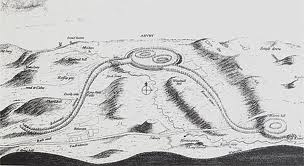

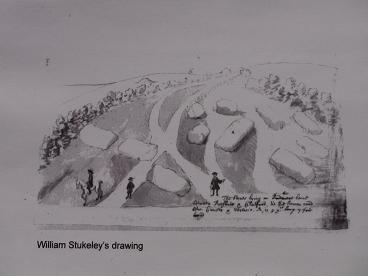
![broad-stones-clatford[1]](https://goudryan.com/wp-content/uploads/2013/04/broad-stones-clatford1.jpg)

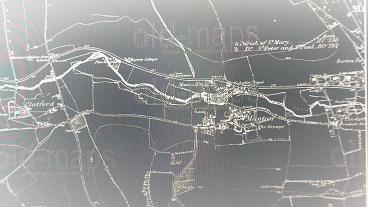 The white curving line through the length of the picture is the Kennet river, the ‘flexure’ is to the left clearly visible, where there is even a small (manmade?) island in the river and after the bend downstream eastwards is a small creek, with trees today, this would have been the ford probably, somewhat further down there is a real ford today (see Google Earth), so fording the Kennet in that area was and is no problem, that is clear enough. Fording places are usually natural and used since time immemorial by humans. Somewhere in the triangle of land in the bend are big stones close to the river today, just as Stukeley describes. All rather straightforward one would say, but not for archaeologists, they dig somewhere else as we shall see. The trees in Stukeley’s picture suggest this is indeed the bend in the Kennet river, which Stukeley mentions in Burl’s quote: “over against Clatford at a flexure in the river we met with several great stones” (note Stukeley has given different descriptions, some more precise than others) so the picture is in the bend, because ‘against Clatford’, where moreover it is known sarsens are still lying till this day, the Broadstones, completely grown over and forgotten by archaeologists, no interest, but vital clues in ‘the route of the sarsens’, of course.
The white curving line through the length of the picture is the Kennet river, the ‘flexure’ is to the left clearly visible, where there is even a small (manmade?) island in the river and after the bend downstream eastwards is a small creek, with trees today, this would have been the ford probably, somewhat further down there is a real ford today (see Google Earth), so fording the Kennet in that area was and is no problem, that is clear enough. Fording places are usually natural and used since time immemorial by humans. Somewhere in the triangle of land in the bend are big stones close to the river today, just as Stukeley describes. All rather straightforward one would say, but not for archaeologists, they dig somewhere else as we shall see. The trees in Stukeley’s picture suggest this is indeed the bend in the Kennet river, which Stukeley mentions in Burl’s quote: “over against Clatford at a flexure in the river we met with several great stones” (note Stukeley has given different descriptions, some more precise than others) so the picture is in the bend, because ‘against Clatford’, where moreover it is known sarsens are still lying till this day, the Broadstones, completely grown over and forgotten by archaeologists, no interest, but vital clues in ‘the route of the sarsens’, of course.
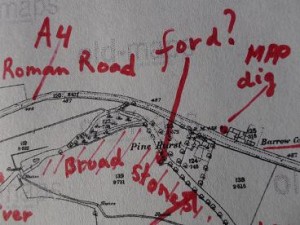
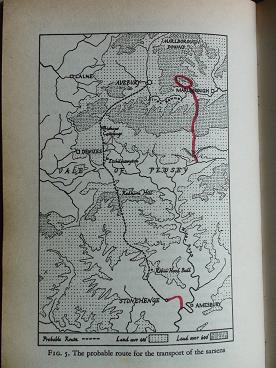




![images[6]](https://goudryan.com/wp-content/uploads/2013/03/images6.jpg)

![mqdefault[1]](https://goudryan.com/wp-content/uploads/2013/03/mqdefault1-300x168.jpg)
![250px-River_Avon_near_Fordingbridge[1]](https://goudryan.com/wp-content/uploads/2013/03/250px-River_Avon_near_Fordingbridge1.jpg)
![288px-River_Avon_at_Salisbury_-_geograph.org.uk_-_31013[1]](https://goudryan.com/wp-content/uploads/2013/03/288px-River_Avon_at_Salisbury_-_geograph.org_.uk_-_310131.jpg)
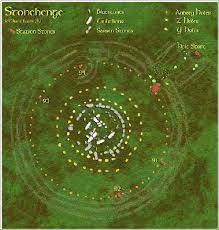
![brodgaraerial[1]](https://goudryan.com/wp-content/uploads/2013/03/brodgaraerial1.jpg)